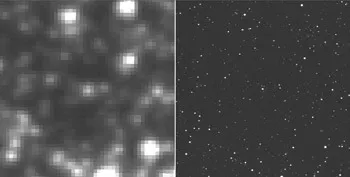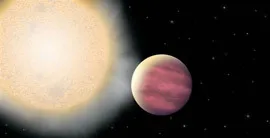Astronomers David Cohen and Eric Jensen, with Students, Aid in Discovery of Two New Planets

The clichéd advice to reach for the stars has proven beneficial for Associate Professors of Astronomy David Cohen and Eric Jensen, who recently contributed to the discovery of two new planets by tracking stars' brightness from the Van de Kamp Observatory on campus. Working in collaboration with the KELT Transit Survey based at Vanderbilt University and Ohio State University, Cohen and Jensen are excited to include student telescope operators Christopher Capron '15 and Peng Zhao '15 in official reports on the discoveries for their work on the night of one of the findings. Jensen co-authored a first draft which detailed the initial results and presented it at a meeting of the American Astronomical Society earlier this month.
The mission of the KELT survey is to discover new planets using transit method, which involves monitoring stars' brightness over time. Cohen and Jensen are particularly interested in dips in brightness of roughly one percent, a potential indicator of a planetary eclipse. Named after the instruments that originally facilitated the project, the survey is centered on data collected from two Kilodegree Extremely Little Telescopes. With diameters of just 3 inches, the instruments are "glorified camera lenses," by Cohen's description, and built from off-the-shelf equipment, making them cheaper than larger, custom projects.

Top: The view from KELT (left) and the Van de Kamp telescope (right). KELT's image has much lower resolution, registering multiple stars as just a single pixel. The KELT team believed the centermost star might be part of a planetary system, but observers from Swarthmore found that a stellar eclipse was occuring in the background, dropping overall brightness of the pixel to one percent, a figure which typically indicates a planetary eclipse.
Bottom: The KELTs' low resolution is a trade-off for its larger field of view. The image on the left shows what the KELTs capture in a single frame; the much smaller image on the right is a single frame from the Van de Kamp telescope. Both images were taken from the same portion of the sky.
"There's a lot of work being done right now on studying planets around other stars," Jensen explains. "We're looking to make a contribution to that. The KELT project's niche is that it's designed to be relatively inexpensive and to target relatively bright stars. These kinds of discoveries are disproportionately interesting because you can tell more about the planets orbiting bright stars than ones further away."
Although small by most standards, the 24-inch telescope housed in the Van de Kamp observatory is large enough to do what the KELTs can't - with higher spatial resolution, it can differentiate between multiple stars that the KELTs register as one. Swarthmore began collaborating with the KELT team this past summer as they turned to astronomers with more powerful telescopes to confirm their initial findings.
According to Jensen, the odds aren't in their favor. "I'd say about 99 percent of the time, it's not a planet," Jensen says.
The more common explanations for the dips in brightness are stellar eclipses, which occur as one star passes in front of another. Because the KELT telescopes cannot always distinguish between multiple stars in the same area, follow-up observations from larger telescopes will often see one of the dimmer stars in a grouping undergo a stellar eclipse, with the result being a one percent decrease in brightness in the whole system - the same as a planetary eclipse.

An artist's rendition of KELT-1b as it orbits its star.
Of the two planets discovered, dubbed KELT-1b and KELT-2Ab, Jensen is particularly excited about the latter. The star that KELT -2Ab orbits is much brighter than most found to have planetary systems; astronomers are already hopeful that this characteristic will make an examination of the planet's atmosphere possible. KELT-1b is unique in its remarkable size - with a mass 27 times that of Jupiter, astronomers believe it to be a "failed star," or brown dwarf, instead of a bona fide planet. Because it's one of the only brown dwarfs found to be in orbit, Jensen believes astronomers can gain valuable insight on similar objects' formation, size, and composition from measurements made as it eclipses its star.
Capron, from Los Angeles, Calif., recalls the atmosphere in the observatory on the night KELT- 1b was first observed. "Professor Jensen was very serious about the object we were going to be observing, saying that previous measurements indicated that it was a likely planet candidate," he says. " I like to think that student observers always get the best data we can, but there was a sense that this was a night when everything had to be completely right." After a semester of operating the telescope, Capron admitted he didn't expect to find a planet, although he kept the possibility at the back of his mind.
Student telescope operators have been involved in the KELT project throughout the past year, tracking stars and measuring brightness during late-night shifts. Jake Neely '13, an astrophysics major from Missoula, Mont., began working on the KELT project at the beginning of last semester and credits his time in the Van de Kamp Observatory with broadening his plans for graduate studies. Of the three or four observations he contributed to the project, he believes all have been false positives.
"It's really exciting, the prospect of finding a planet," he says of his work. "Before starting on the project, I was very focused on theoretical physics and hadn't really considered working with telescopes or working with data, but it's been a good experience. It's opened up my horizons to considering Ph.D. programs that aren't purely theoretical."
"Science is a little bit weird because the classroom learning and practical doing are so different," Cohen says. "When you're doing research, there's a lot of uncertainty. Not only does nobody know the answer, including your professor, but you're not even sure you can find an answer. I think the mindset of a scientist has to simultaneously value orderliness and the tying up of loose ends, but also has to value the open-endedness and uncertainty that's intrinsic to research. I think one of the very valuable opportunities we can provide science and non-science students at Swarthmore is showing them more of that second thing, the open-endedness and uncertainty that goes along with scientific research and complements the theoretical learning they do in the classroom."
With many more potential stars to consider, the KELT collaboration is set to continue for years to come at Swarthmore. In addition to KELT-1b and 2-Ab, at least two more planet candidates are currently in the process of being officially confirmed based on observations from Swarthmore and additional teams. For Cohen, Jensen, and students employed by the Physics and Astronomy Department, the search isn't over yet.
"One of the greatest things about working at the observatory is that I can add 'Telescope Operator' to my resume, which is a kind of uniquely quirky bonus that few places other than Swarthmore can provide," says Capron. "It has also given me a greater appreciation for the kind of research that Swarthmore engages in and the position it holds in world's scientific community. Finally, working at the telescope is simply fun. The other observers are great, the faculty is very patient and helpful, and at the end of the day I can say that I've learned something about the universe outside of the classroom. It's a job I'd recommend to everyone."



